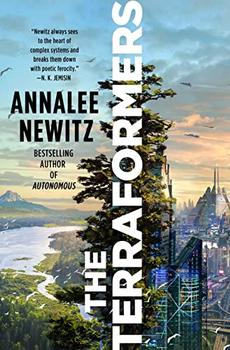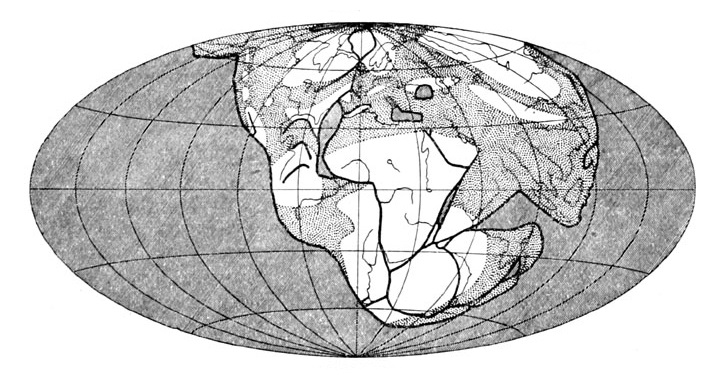Summary | Excerpt | Reviews | Beyond the Book | Read-Alikes | Genres & Themes | Author Bio

This article relates to The Terraformers
 In Annalee Newitz's science fiction novel The Terraformers, characters threaten to trigger the development of plate tectonics on the planet Sask-E as a form of political leverage. The theory of plate tectonics has revolutionized our understanding of our planet and its geological processes. This theory states that the outer layer of Earth, known as the lithosphere, is not one unbroken piece but many "plates," which shift around on the asthenosphere beneath them. The movement of these plates as they crash into each other, pull apart, or move past each other causes earthquakes and volcanic eruptions, and over very long periods of time, forms mountains and oceans, and even moves continents.
In Annalee Newitz's science fiction novel The Terraformers, characters threaten to trigger the development of plate tectonics on the planet Sask-E as a form of political leverage. The theory of plate tectonics has revolutionized our understanding of our planet and its geological processes. This theory states that the outer layer of Earth, known as the lithosphere, is not one unbroken piece but many "plates," which shift around on the asthenosphere beneath them. The movement of these plates as they crash into each other, pull apart, or move past each other causes earthquakes and volcanic eruptions, and over very long periods of time, forms mountains and oceans, and even moves continents.
Though there had been conjecture since the 16th century about how the continents had once been joined before drifting apart, Alfred Wegener, a German geophysicist, was one of the first to develop these observations into a complete theory. In 1912, he suggested that Earth once had one "supercontinent," which had broken apart and shifted over very long periods of time, citing as evidence the fact that the east coast of South America and west coast of Africa are the inverse of each other, so they could fit together almost like matching puzzle pieces. He called this idea "continental drift," and it was further supported by similarities in geological formations and fossilized species on continents that today are separated by vast distances. However, Wegener's theory failed to convincingly explain how the continents might have moved, so it did not gain much traction in his lifetime.
World War II inspired numerous technological developments that enabled scientific breakthroughs, including improvements to oceanic mapping. In 1962, American geoscientist Harry Hess introduced the idea of seafloor spreading, based on maps of the ocean. He theorized that magma pushed upwards at mid-ocean ridges, creating new ocean floor and forcing the old ocean floor to spread outwards until it reached oceanic trenches, where it melted back into the mantle. This gave scientists an explanation of how continental drift could occur, though more evidence was still needed. Improved capabilities for sensing earthquakes helped to provide that evidence. Scientists discovered that the majority of earthquakes happen in specific areas, often the same areas that form volcanos. These areas show us the outlines of tectonic plates. Additionally, changes in the seismic waves as they moved deeper into the Earth showed that the difference in density between the rigid lithosphere (which is generally 60 miles or more deep but thins to around two miles at ocean spreading centers) and the more malleable asthenosphere allow the plates to move. This is caused by convection, with cooler material sinking and hotter material rising, pushing the plates on the surface.
Earth's tectonic plates have a huge impact on the planet's development, so scientists are eager to find out how tectonic systems on other planets compare. For instance, a study that came out in May 2021 shows evidence that Venus' crust is fragmented into blocks that show some signs of movement. These do not appear to function in the same way as Earth's plates, but may be caused by convection in the mantle. If that is the case, studying tectonic activity on Venus may help us to understand Earth's tectonics in the far past, when our planet had a comparable temperature and make up to Venus today. NASA has two missions planned for Venus this decade, and the researchers are hopeful they will shed new light on this topic.
Alfred Wegener's depiction of Pangaea, courtesy of Wikimedia Commons
Filed under Medicine, Science and Tech
![]() This "beyond the book article" relates to The Terraformers. It originally ran in February 2023 and has been updated for the
September 2023 paperback edition.
Go to magazine.
This "beyond the book article" relates to The Terraformers. It originally ran in February 2023 and has been updated for the
September 2023 paperback edition.
Go to magazine.
Great political questions stir the deepest nature of one-half the nation, but they pass far above and over the ...
Click Here to find out who said this, as well as discovering other famous literary quotes!
Your guide toexceptional books
BookBrowse seeks out and recommends the best in contemporary fiction and nonfiction—books that not only engage and entertain but also deepen our understanding of ourselves and the world around us.